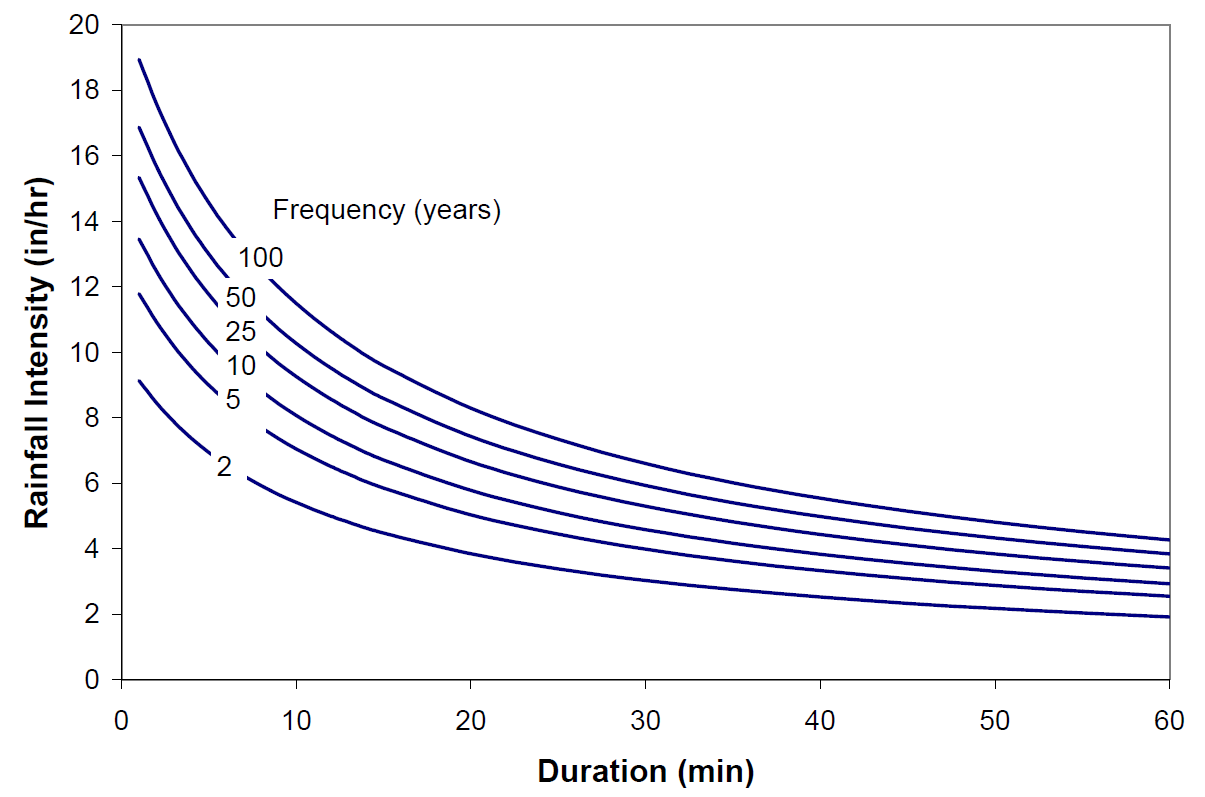Rainfall Intensity
The rainfall intensity (I) is the average rainfall rate in in./hr. for a specific rainfall duration and a selected frequency. The duration is assumed to be equal to the time of concentration. For drainage areas in Texas, you may compute the rainfall intensity using Equation 4-21, which is known as a rainfall intensity-duration-frequency (IDF) relationship (power-law model).

Equation 4-21.
Where:
- I= design rainfall intensity (in./hr.)
- t= time of concentration (min) as discussed in Section 11c
- e,b,d= coefficientsbased on rainfall IDF data.
In September 2018, the National Oceanic and Atmospheric Administration (NOAA) released updated precipitation frequency estimates for Texas. These estimates are available through
(PFDS) website and the report documenting the approach is also available at the same website - NOAA Atlas 14, Volume 11: Precipitation-Frequency Atlas of the United States. This new rainfall data is considered best available data and should be used for all projects. Tabular IDF data are available from the PFDS, but linear interpolation or curve generation is needed to obtain intensity values between tabular durations. Ongoing TxDOT research will produce future e, b, d coefficients to better automate intensity calculations. However, barring significant project implementation concerns, Atlas 14 IDF data should be used. Exceptions must be approved by the DHE or DES HYD and noted on the plans or drainage report.
Currently, the coefficients in Equation 4-21 can be found in the
spreadsheet lookup tool (developed by Cleveland et al. 2015) for specific frequencies listed by county (See video/tutorial on the use of the EBDLKUP-2015v2.1.xlsx spreadsheet tool). This spreadsheet is based on prior rainfall frequency-duration data contained in the Atlas of Depth-Duration Frequency (DDF) of Precipitation of Annual Maxima for Texas (TxDOT 5-1301-01-1).
If a project is approved to use the older values from the
spreadsheet lookup tool or from existing functionality in design software like GEOPAK, they should still evaluate the new NOAA rainfall changes for their project area and, if there are increases for the design frequency, estimate an appropriate level of freeboard for use. The freeboard amount and a description of how it was generated should be noted in both the plans and the drainage report. Software that facilitates Rational Method calculations often has IDF curves from rainfall data embedded into the software. Location-specific IDF from the new NOAA rainfall data can be imported for each project into the software.
TxDOT is currently working with Texas Transportation Institute (TTI) staff, as part of research project 0-6980, to update the IDF curve relationships for the state of Texas based on the 2018 NOAA rainfall data. This work will include an update of the EBDLKUP-2015v2.1.xlsx file linked above and planned for inclusion in the next HDM update.
The general shape of a rainfall
IDF
curve is shown in Figure 4-9. As rainfall duration approaches
zero, the rainfall intensity tends towards infinity. Because the rainfall intensity/duration relationship is assessed by assuming that the duration is equal to the time of concentration, small areas with exceedingly short times of concentration could result in design rainfall intensities that are unrealistically high. To minimize this likelihood, use a minimum time of concentration of 10 minutes. As the duration tends to infinity, the design rainfall tends towards zero. Usually, the area limitation of 200 acres for Rational Method calculations
should result in rainfall intensities that are not unrealistically low. However, if the estimated time of concentration is extremely long, such as may occur in extremely flat areas, it may be necessary to consider an upper threshold of time or use a different hydrologic method.
Figure 4-9. Typical Rainfall Intensity Duration Frequency Curve
In some instances alternate methods of determining rainfall intensity may be desired, especially for coordination with other agencies. Ensure that any alternate methods are applicable
and documented
.